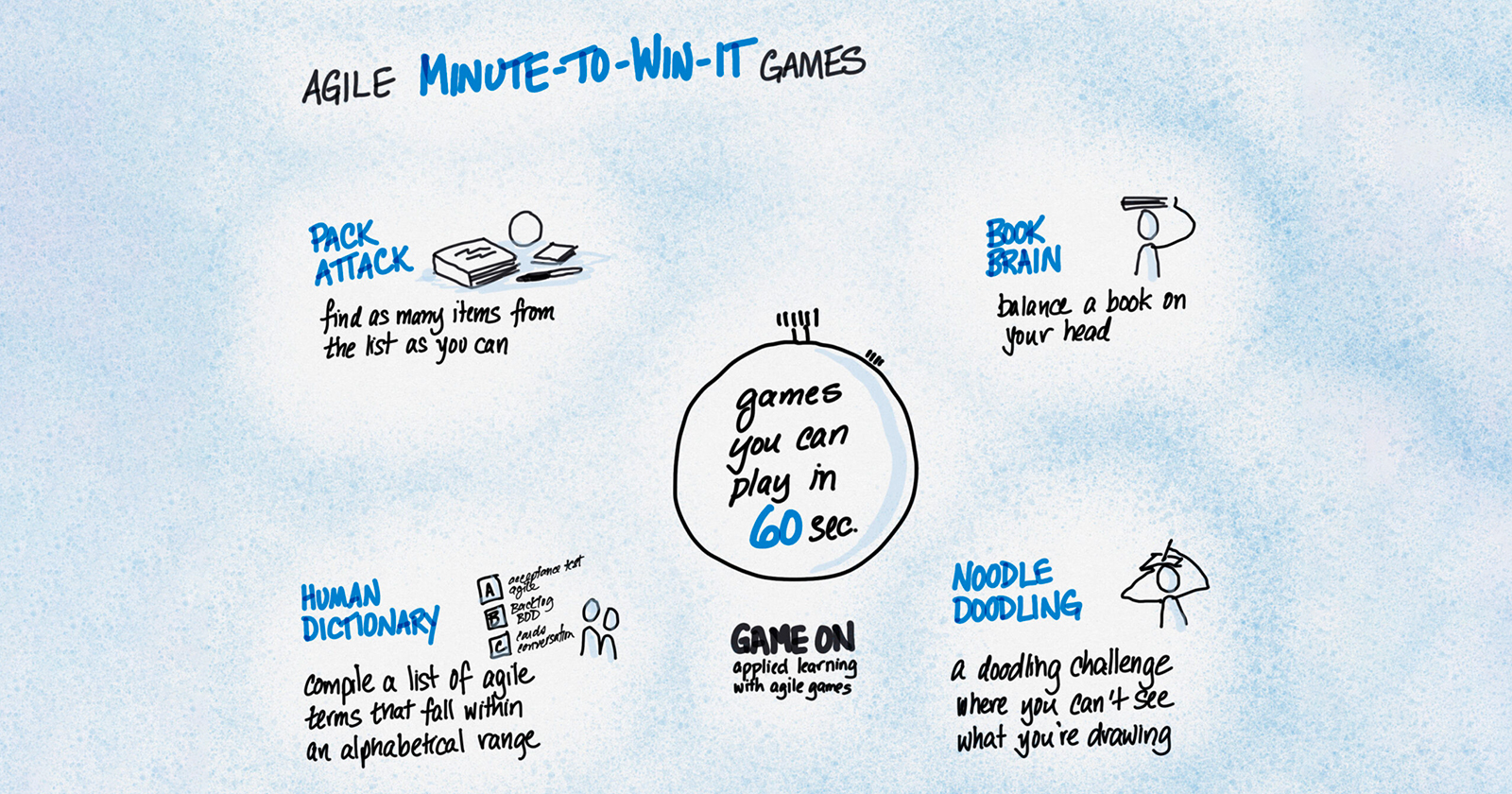Sometimes, you need a really quick game to liven up a meeting or workshop. For October’s Game On!, we hacked some of the popular Minute-to-Win-It Games to add some Agile flavor. Minute-to-Win-It games are quick, whimsical, and low-tech, and–best of all–can be played in 60 seconds. With a little ingenuity and framing, you can use these quick games to cultivate Agile thinking with your team.
Pack Attack
In this very quick scavenger hunt, participants have 60 seconds to assemble a collection of random items. Our list of items was:
- Agile book
- marker or writing utensil
- spoon
- tissue or tp
- sticky notes or paper
- planning poker cards (or any card deck)
- lotion ;l
- car keys
- coat/jacket/hoodie
- notebook
- charging cables
- picture frame
- candy
- ball
- headphones/headset
- stuffed animal
- LEGO
How we hacked this game:
- We rewrote the list of items to include the items we wanted for the next games. This might be useful for an online workshop where participants need specific supplies.
What participants talked about in the debrief:
- This is a game where people working remotely might have an advantage over people in the office.
- People interpreting list items differently demonstrated how easy it is for written requirements to mean different things to different people.
Book Brain
Players need to balance a book on their head for 60 seconds. If they’re feeling confident, they can experiment with moving–can they stand or move while keeping the book balanced?
How we hacked this game:
- Use an Agile book (so that we’d have the book subjects to talk about)
What participants talked about in the debrief:
- Great game to use as an energizer, a focus/mindfulness exercise, or to introduce a discussion on balance
- While the game was underway, we had a conversation about which books people used–it was a great way to find out what people might be reading.
- We also had an interesting discussion about how to make this (and other games) more accessible. Stay tuned for an upcoming Game On! on this theme….
Human Dictionary
In small groups, players need to compile a list of Agile terms that fall alphabetically within a set range. We used the ranges:
- Acceptance Test to Customer
- Daily Standup to Frequent Release
- Given-When-Then to Joy
- Kanban to Mob Programming
- Niko-Niko to Quick
- Refactoring to Sustainable Pace
- Task Board to Version Control
How we hacked this game:
- Rather than specifying a single letter of the alphabet, we gave players a broader range to find words in between because we wanted them to find as many Agile terms as possible.
- We also gave teams a little longer (2 minutes) as we were seeking specific types of words, which made the task a bit more challenging.
What participants talked about in the debrief:
- Teams collaborated quite differently to increase creativity
- Some players offered a whole pile of words that were correct alphabetically but maybe not agile, which helped other people.
- Some players built off a word that was offered–for example, elaborated on “backlog” to add “backlog item” or “backlog refinement.”
- There was also some debate about whether terms belonged on a list of “Agile words” or not (looking at you, “Gantt chart”)
Noodle Doodle
Players must draw the prompt that’s given in 60 seconds–the catch is that the drawing paper is on top of their head while drawing! We started with drawing a pet, then moved on to Agile drawing prompts: burnup or burndown chart, daily standup with Kanban board.
How we hacked this game:
- We gave players the option of drawing other ways as long as they couldn’t see the paper. Some opted to wear a blindfold, while others simply turned their heads away from the page or closed their eyes rather than placing the paper on top of their heads.
What participants talked about in the debrief:
- This game was silly and fun. If you’re playing this in the office, the people walking past *will* wonder what you’re up to.
- You could use this (or a human dictionary) in a workshop or training session to review new terminology or concepts.
We hacked four Minute-to-Win-It games in this session–a quick search will turn up dozens more that can be adapted to suit your team’s circumstances.
Join us on November 1, at 11 AM EDT for the next Game On, featuring guest gamers Dennis Wagner and Marc Bless, authors of the “Agile Games and Simulations” book.



![[Case Study] From merger chaos to Agile greatness](https://www.agilealliance.org/wp-content/uploads/2025/01/chaos-to-greatness-color-150x150.jpg)



![[Case Study] From merger chaos to Agile greatness](https://www.agilealliance.org/wp-content/uploads/2025/01/chaos-to-greatness-color-300x158.jpg)

